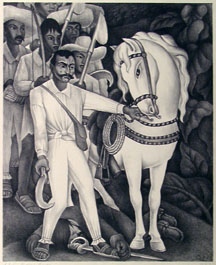
 Diego Rivera
Diego Rivera
(Mexican, 1886-1957)
Zapata, 1932
Lithograph
In the 1920s, the Mexican government asked Diego Rivera to participate in a cultural program that would promote the arts and culminate in an increased sense of national pride. Rivera was asked to create works of art, mainly prints, which would be widely distributed in order to convey an important social message to Mexican citizens. This art project was supervised by the graphic artist, Jose Posada and because of Rivera’s respect for Posada, he agreed to produce prints devoted to the peasant revolution
Maintaining the contextual relationship between Mexican art and its changing history, Rivera produced works of art depicting the major figures in the struggle for peasants’ rights. A prominent leader in the peasant uprising was Emiliano Zapata. Zapata often appears in the work of the twentieth century Mexican artists such as Jose Clemente Orozco and David Alfaro Siqueiros. The lithograph in Muhlenberg’s collection is among one of the most famous images of Zapata and is representative of an important figure in Mexico'’s history.
All art images and content are the property of Martin Art Gallery, Muhlenberg College, Allentown, PA. Any reproduction or distribution of this material without the expressed, written consent of the Martin Art Gallery is prohibited and a violation of federal law. All rights reserved.
